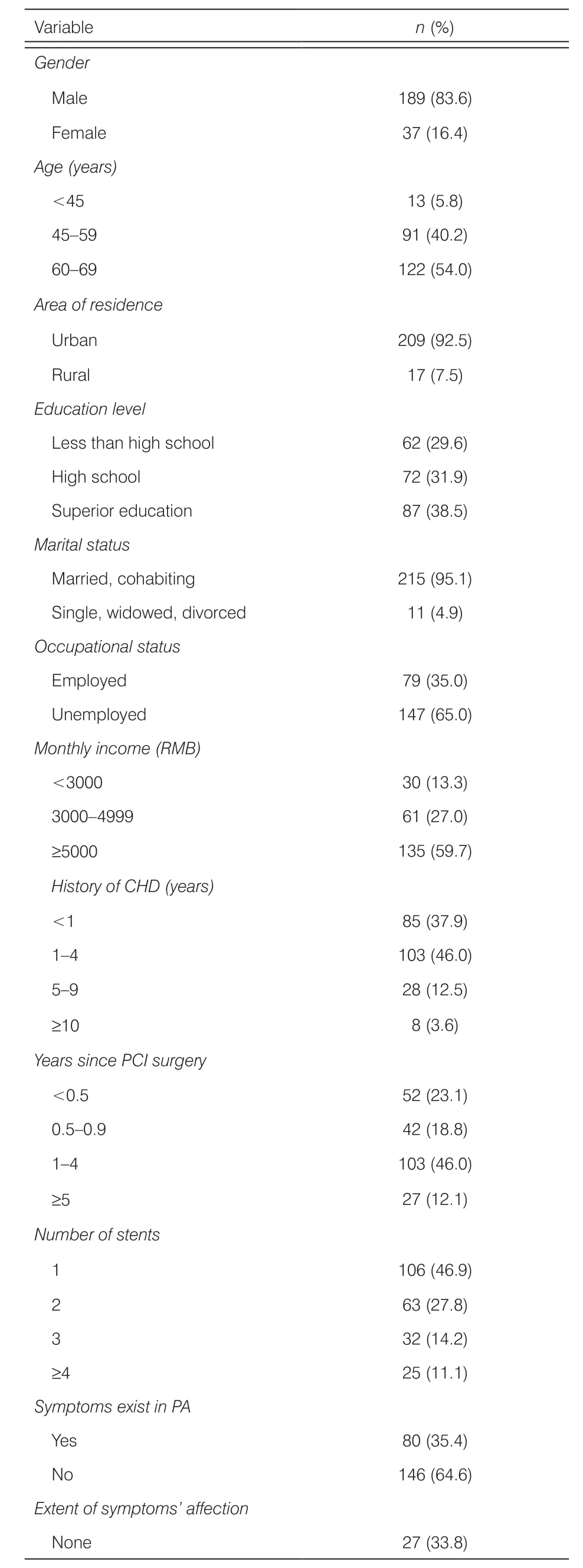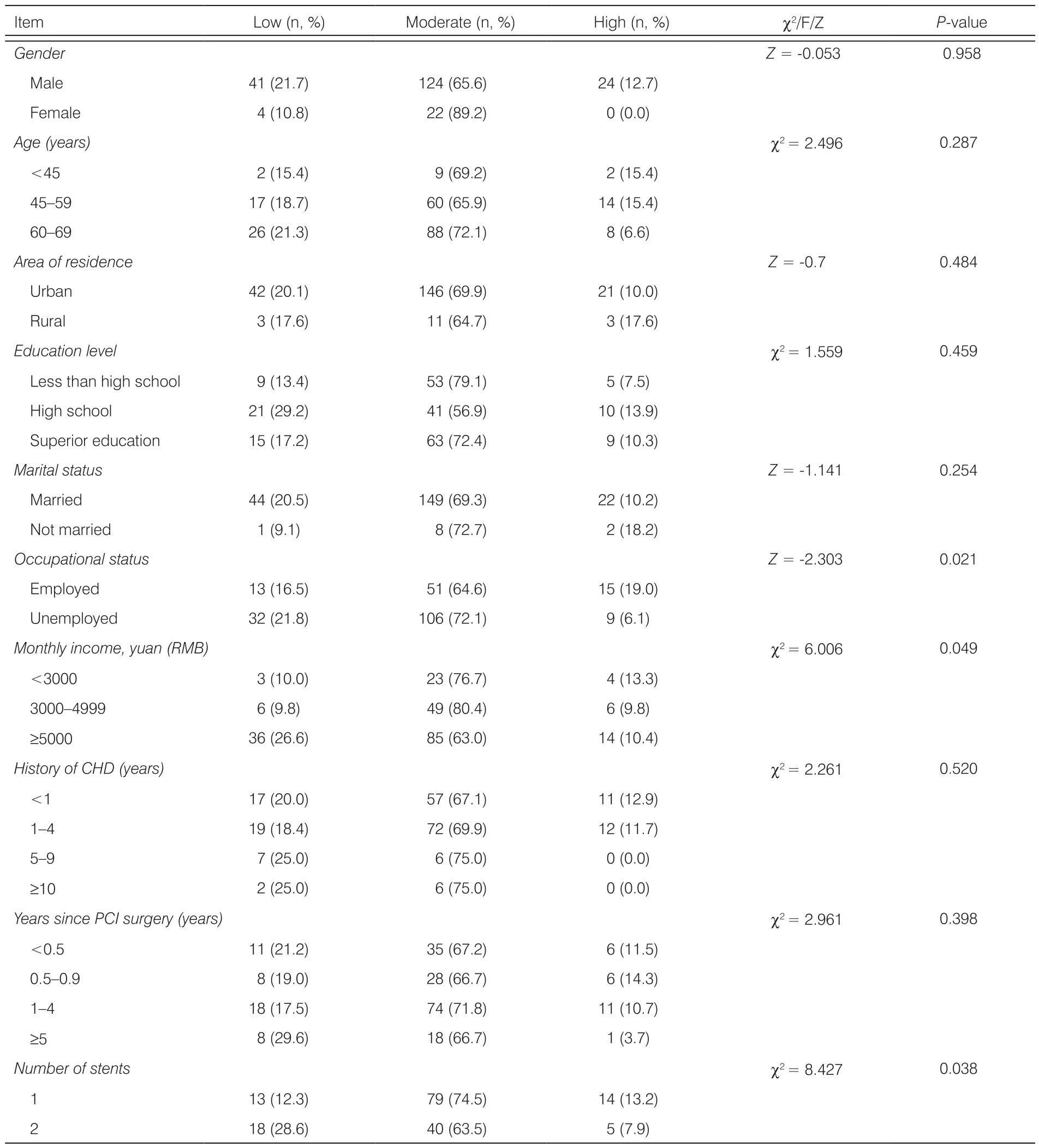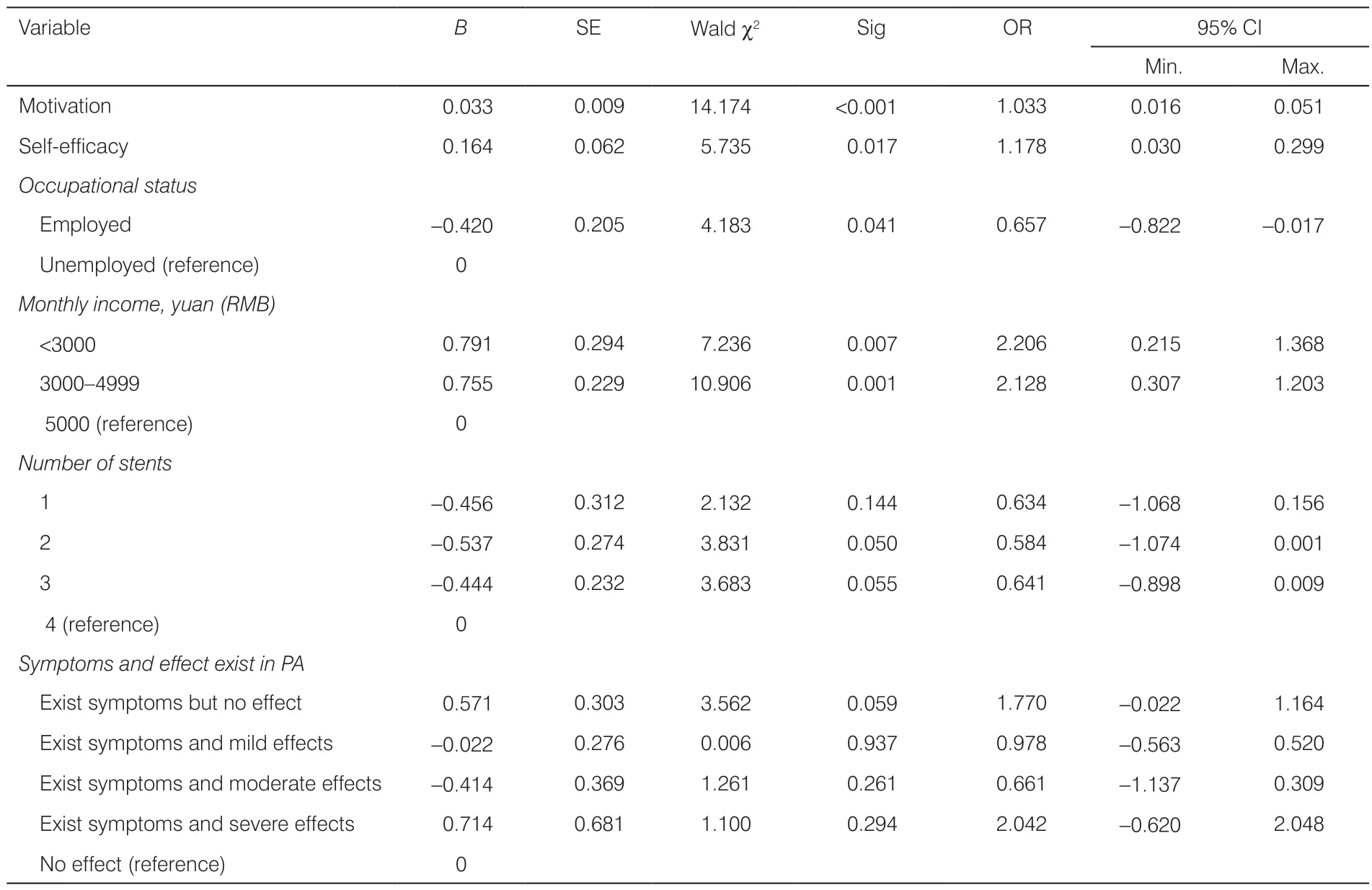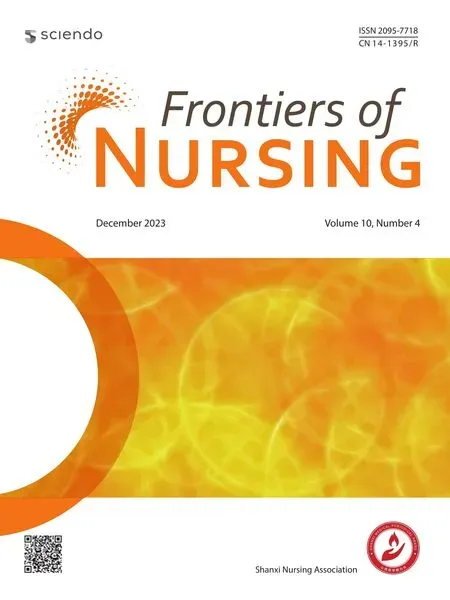Physical activity levels and predictors in patients following percutaneous coronary intervention: a cross-sectional study
2023-12-15XioLinFengShoMeiShngShunLinXuHongBoChenYunLinWng
Xio-Lin Feng ,Sho-Mei Shng,Shun-Lin Xu ,Hong-Bo Chen ,Yun-Lin Wng
aSchool of Nursing, Hunan University of Chinese Medicine, Changsha, Hunan 410208, China
bSchool of Nursing, Peking University, Beijing 100191, China
cCardiac Centre, Peking University Third Hospital, Beijing 100191, China
Abstract: Objective:To examine physical activity (PA) of post-percutaneous coronary intervention (PCI) patients and explore the demographic,clinical,and social psychological characteristics associated with PA levels.Methods:A total of 246 post-PCI patients from the Peking University Third Hospital in Beijing,China,were included in this crosssectional study through convenience sampling.Data were collected from a self-reported questionnaire.PA was categorized into low,moderate,or high levels.The ordinal multinomial logistic regression model was used to estimate the relationship among demographic,medical,and psychosocial characteristics.Results:The overall prevalence of low,moderate,and high PA was 20%,70%,and 10%,respectively.For the domain-specific PA patterns,most participants took part in leisure-time PA (84.5%);walking was the most common PA.Increased motivation and selfefficacy,lower monthly income,and unemployment were predictors of high PA.Conclusions:PA levels in post-PCI patients was not optimal,and leisure-time PA had the highest participation rate.Analyses of influencing factors can provide medical staff and health workers information to focus on high-risk groups and introduce more tailored interventions.Future studies can explore more regions,and ecological models can be introduced to study more influencing factors.
Keywords: cardiac rehabilitation • determinant • percutaneous coronary interventions • physical activity • prevalence
1.Introduction
Physical inactivity is common worldwide,especially among people with chronic diseases or disabilities who have fewer opportunities to be active.1In 2018,the World Health Organization (WHO) endorsed a global action plan on physical activity (PA) and agreed to a target of 15% relative reduction in the prevalence of insufficient PA by 2030.2Many advances have been made to increase PA worldwide,but there is still insufficient activity in people following percutaneous coronary intervention (PCI).
PCI has been firmly established as the most important procedure used for an invasive treatment in ischemic heart disease.It has rapidly evolved,and its utilization rate has increased dramatically over the past years.3However,the PCI procedure and drug therapy alone cannot effectively improve the prognosis of patients.PCI can neither reverse or slow down the biological process of atherosclerosis nor eliminate the risk factors of heart disease.4,5Stent thrombosis (ST) and in-stent restenosis are two major problems following the PCI procedure,which present as recurrent angina,acute myocardial infarction,or sudden death.Approximately 10% of patients have repeat percutaneous revascularization.6,7In addition,decreased exercise tolerance,anxiety,and depression after the PCI procedure seriously affect the quality of life of patients.The American Heart Association (AHA) guidelines recommend PA-based cardiac rehabilitation for secondary prevention after PCI.8
In China,exercise rehabilitation after coronary intervention is in its infancy.Health workers still focus on rescue and treatment in the acute stage of the disease,and there is a lack of understanding and practice of exercise rehabilitation.PA in post-PCI patients causes a high risk of cardiovascular disease recurrence and brings a huge economic burden and labor loss to the family and the country.Therefore,it is imperative to carry out exercise rehabilitation in China.First,the current situation within the population should be understood.However,data on PA in post-PCI patients are insufficient.Some results are not comparable due to different data collection or analysis formats,making it difficult to judge the quality of the PA.Moreover,the priorities and preference for domain-specific PA in post-PCI patients remain unknown.In addition,the factors that influence PA in post-PCI patients are not completely understood.Hence,the objective of the present study was to examine PA of post-PCI patients and explore the socio-demographic,clinical,and social psychological characteristics associated with PA levels.
2.Methods
2.1.Study design and participants
The present cross-sectional study was conducted from September 2017 to February 2018 in the Cardiovascular Department of the Peking University Third Hospital in Beijing.The convenience sampling technique was used for participant selection.Sample size was determined by using the formula for a cross-sectional study:.9A previous study used the International Physical Activity Questionnaire (IPAQ) to investigate the post-PCI population in China and showed that inadequate PA accounted for 70% of the post-PCI population.10A sample size of 246 was calculated usingP=0.7,0.05 alpha,Z=1.96 at the 95% confidence interval (CI),a margin of error of 6%,9and a 10% estimated non-response rate.The inclusion criteria in this study were as follows: (1) patients who underwent emergent or elective PCI;(2) patients who received the latest cardiopulmonary function test,echocardiography,and blood test results that met the low-risk stratification criteria of exercise recovery risk after PCI,including no angina pectoris symptoms,no ECG ischemic changes and complex arrhythmia,a left ventricular ejection fraction of≥50%,normal cardiac concentration,and B-type natriuretic peptide concentration;(3) patients who underwent PCI at least 2 weeks from the time of the study because patients were able to participate in PA 2 weeks post-PCI;(4) patients who were 18–69 years old;(5) patients with good understanding and communication skills;and (6)patients who voluntarily participated.Patients who were participating in a study of PA intervention were excluded from our study.
2.2.Data collection
2.2.1.PA behavior
The long version of the IPAQ was used to obtain selfreported PA behavior.11The questionnaire consisted of 27 questions and was structured to provide separate domain-specific scores for walking and moderate-and vigorous-intensity PA participation in 4 settings,namely,work,transportation,housework,and leisure-time activities.The IPAQ has acceptable reliability and validity in Chinese people.The retest reliability was good,with intra-class correlation coefficients ranged from 0.74 to 0.94.The Spearman correlation coefficients were statistically significant for PA compared with the accelerometry-based criterion measures.12Both continuous and categorical variables were available.Continuous variables were presented as metabolic equivalent (MET)-min/d or MET-min/week.Categorical variables were classified into 3 levels: low,moderate,and high.13
2.2.2. Motivation
Liu14introduced the Self-Regulation Questionnaire(TSRQ) developed by Williams et al.15and formed a Chinese version specially for understanding the PA motivation level of patients with coronary heart disease (CHD).The questionnaire contains 3 dimensions,namely,autonomy motivation,external regulation,internal regulation,and 12 additional items.A 7-point Likert scale was used,and higher scores indicated a relatively higher level of motivation.The questionnaire had excellent internal consistency,with a 0.906 Cronbach’s alpha,and good construct validity with confirmatory factor analysis,which indicated a good model fitness.14
2.2.3. Self-efficacy
Self-efficacy was assessed using the 6-item Chronic Disease Self-Efficacy (CDSE) Scale,which is a measure of how confident patients with chronic disease are in doing certain activities.The CDSE measurement represented symptom management,role function,emotional control,and communication with doctors.16In addition,a 10-point Likert scale was used.The self-efficacy score was the total average score of 6 items;a higher number on the score represented a higher self-efficacy.The scale has been widely used since introduced into China,with good reliability and validity.17
2.2.4. Social support
Social support was assessed using the Social Support Rating Scale (SSRS) developed by Xiao18,which evaluates the level of social support of general people and is currently the most widely used social support scale in China.19The SSRS includes 10 items and 3 dimensions,namely,objective support,subjective support,and the utilization of support.In addition,a 4-point Likert scale was used.The total score ranged from 12 to 66 points,with high levels indicating a high social support level.The SSRS had good reliability and validity,with an internal consistency of 0.76 and a test–retest reliability of 0.92.20,21
2.2.5. Socio-demographic and clinical information
Age,gender,area of residence,marital status,education level,occupational status,monthly income,history of CHD,years since PCI surgery,number of stents,symptoms exist in PA,extent of symptoms’affection,complications,and discomfort symptoms during the activity were measured with a self-designed questionnaire.These were considered categorical variables.
2.3.Data collection procedure
The trained research team approached potential subjects in the patient’s waiting room and explained the purpose of the study.Patients who were interested in the study were screened for eligibility by researchers and were informed of the significance and precautions.Then,the patients filled out informed consent forms.Questionnaires were given to the participants and completed.The questionaries were returned to researchers in the waiting room.
2.4.Ethical consideration
The present study was approved by the Biomedical Ethics Committee (protocol: IRB00001052-17096).All participants signed the informed consent form and filled out the questionnaire anonymously.
2.5.Data analysis
Statistical analyses were performed using SPSS 22.0(IBM Corporation,Armonk,New York,United States).Psychological characteristics,including motivation,self-efficacy,and social support,were presented as continuous variables,and PA,socio-demographic,and clinical information were presented as categorical variables.Descriptive statistical measurements of mean ±standard deviation(SD),median (M),and interquartile range (IQR) were used for continuous variables.Frequency and percentage were used for categorical variables.In univariate analysis,differences between motivation,self-efficacy,and social support in PA groups were calculated using one-way ANOVA.The Non-parametric tests used for category variables were ordinal or nominal.The Mann–Whitney test was used for binary variables,and the Kruskal–Wallis test was used for multinomial variables.An ordinal logistic regression analysis was performed to identify predictors of higher-level PA.Variables that were significantly associated with PA levels in the univariate analyses were included in the model.PA was selected as dependent variables and classified into group 1 (low level),group 2 (moderate level),and group 3 (high level).Motivation (continuous value),self-efficacy (continuous value),occupational status (unemployed=1 and employed=2),monthly income (>5000 RMB=1,3000–5000 RMB=2,and <3000 RMB=3),number of stents (>4=1,3=2,2=3,and 1=4),and symptoms and effects that exist in PA (no effect=1,symptoms exist with severe effects=2,symptoms exist with moderate effects=3,symptoms exist with mild effects=4,and symptoms exist with no effect=5) were considered independent variables.For all statistical tests,two-tailedPvalues <0.05 were considered statistically significant.
3.Results
3.1.Demographics of the participants
A total of 245/246 participants returned the completed questionnaire.After removing the data from missing and out-of-range values,226 valid questionnaires were retained.The majority of participants were male(83.6%),and their mean age was 58.58 ± 7.57 years,with 65.0% of them unemployed.The duration M (IQR)of CHD was 2.00 (0.67,4.08) years.M (IQR) of the postoperative time was 1.79 (0.58,4.00) years.Further details of socio-demographic and medical information are given in Table 1.

Table 1.Socio-demographic,medical,and psychological characteristics of the patients (n=226).
3.2.PA level
Total PA constituted low,moderate,and high levels of PA.A total of 10%,70%,and 20% of patients exhibited high,moderate,and low levels of PA,respectively.Many participants participated in leisure-time PA (84.5%),and walking was the most common PA (Table 2).

Table 2.Composition of 4 domains of PA.
3.3.Univariate analysis of low,moderate,and high levels of PA
Table 3 compares the socio-demographic,medical,and psychological variables among the 3 levels of PA.Occupational status (Z=-2.303,P<0.05),monthly income(χ2=6.006,P<0.05),number of stents (χ2=8.427,P<0.05),PA symptoms (Z=-2.204,P<0.05),extent of effected symptoms (χ2=9.684,P<0.05),motivation(F=14.105,P<0.001),and self-efficacy (F=11.806,P<0.001) displayed significant differences between PA levels (Table 3).

Table 3.Univariate analysis of low,moderate,and high levels of PA.
3.4.Multivariate logistic regression analysis between levels of PA
Five significant variables from the univariate analysis were included in the multivariate logistic regression model to determine the effect on low,moderate, and high levels of PA.A test of parallelism indicated that slope coefficients in the model were similar across response categories (χ2=17.903,P=0.119).The goodness-of-fit statistic showed the final model fitted well(χ2=62.776,P<0.001).Analyses revealed that (a) participants with higher motivation were 1.03 times more likely to increase one level of PA (95% CI: 0.016–0.051),(b) participants with higher self-efficacy were 1.178 times more likely to increase one level of PA (95% CI:0.030–0.299),(c) employed patients had a probability of 0.657 times more likely to increase one level of PA than unemployed patients (95% CI: -0.822 to -0.017),and (d)patients who received <3000 RMB/month or 3000–5000 RMB/month had a probability of 2.206 times (95% CI:0.215–1.368) and 2.128 times (95% CI: 0.307–1.203),respectively,to increase one level of PA compared with people whose monthly income was ≥5000 RMB(Table 4).

Table 4.Ordinal multinomial logistic analysis on the predictors of PA.
4.Discussion
The present study was one of the first to investigate the levels of PA and associated socio-demographic,medical,and psychological factors among post-PCI patients in China using the IPAQ.Our study indicated that 20% of people have insufficient PA,and the most popular PA activities were walking and leisure PA.Motivation,self-efficacy,occupational status,and monthly income were predictors of high PA.This finding provides a basis for medical workers to carry out health education and PA intervention and lays a foundation for the development of exercise rehabilitation in post-PCI patients.
We observed that 20% of PCI patients had insufficient PA,which is relatively high compared to the general population22.When compared with other types of cardiovascular disease,such as acute coronary syndrome and CHD,the percentage of PA was relatively low.23,24Therefore,insufficient PA observed in PCI patients was lower than in patients with other types of cardiovascular disease,but inferior to the general population.The high-level PA participation rate was lower than the PA of the general population25and other types of cardiovascular patient population,23indicating that high level of PA was insufficient.PA has been well established by the 2020 WHO guidelines to be a health benefit in adults with chronic conditions.Therefore,improving the high-level of PA participation in PCI patients is a problem that needs to be solved.
For the domain-specific PA,several surveys on the general population and people with diabetes have shown that PA was mainly based on work,housework,or transportation.26–28Unlike previous reports,our study found that leisure-time PA accounted for the majority of PA,with a participation rate of 80%.This rate was higher than that from a recent survey involving a large Chinese sample population.29This result may be ideal because the benefit of leisure-time PA has been well established and might be more amendable to change during cardiac rehabilitation.In future studies,health care workers could provide scientific guidance for patients to carry out leisure-time PA.
Higher motivation,self-efficacy,unemployment,and lower monthly income predicted higher PA levels.Previous studies have comprehensively explored the factors that influence PA within the general population and cardiovascular patients,but the findings have been inconsistent,except for self-efficacy and motivation.30,31Similar results were obtained in the present study that showed motivation and self-efficacy were predictors of high-level PA in post-PCI patients.
The influence of occupational status on PA has been extensively studied in the cardiovascular disease population.32Whether patients return to work after a major event,like surgery or a heart attack,and its impact on their life and behavior after returning to work are a matter of concern.The present study showed that unemployed patients have a higher level of PA,which may be related to sufficient time and less work pressure.
The high-income population was more likely to have insufficient PA.Previous studies have suggested that high-income countries had a transition toward more sedentary occupations and personal motorized transportation;conversely,in lower-income countries,more activity is undertaken at work,transport,and housework,which provides some insight into the interpretation of our results.22Further analysis in our research showed that transport PA levels with a monthly income below 3000 RMB,3000–5000 RMB,and above 5000 RMB were 420.5,286.5,and 224.7 MET-min/week,respectively,and the housework PA levels were 290.5,226.2,and 177.2 MET-min/week,respectively.This indicates that with the increase in income,transport and housework PA levels tend to decrease;however,work-related and leisure-time PA levels did not increase correspondingly.Therefore,more attention should be paid to highincome patients.
The effect of social support on PA is uncertain.From the current research,social support was found to be more effective for promoting PA in people with cardiovascular disease than in the general population.30,31However,the present study showed that social support had a non-significant impact on PA.These results may be partly attributed to gender as the majority of the participants in the current study were male.By contrast,previous studies have shown that women generally had a wider network of relationships than men and were more vulnerable to social support.33Similarly,social support may have had an indirect effect on PA.34Thus,a PA-specified social support questionnaire may be needed in future studies.
In the present study,symptoms did not influence PA,which is contrary to the findings from previous studies.35First,the reason for this difference could be because of the subjective nature of the survey questions,affecting the accuracy of the results.Second,studies have shown that symptoms may affect the confidence and self-efficacy of certain behaviors by influencing anxiety and depression;therefore,it is necessary to explore the influence of mediating variables.36There are a few studies on the effect of the number of stents on PA.With the continuous development and improvement of the PCI technology,the scope of application has been broadened,and the proportion of blockage treatment for complex coronary lesions has been increasing.Therefore,the number and total length of stents are also increasing.The correlation between the number of stents and cardiovascular adverse events has been confirmed.37However,whether the number of stents is related to PA and the mechanism of action needs to be further confirmed by more studies.In addition,the small sample size may also be the reason why these two factors are not significant.
5.Limitation
The present study had some limitations.The data collection of the IPAQ was self-reported,and we expect selected memory bias and exaggeration,which could reduce the reliability of the results.However,the use of a questionnaire was still the most convenient and economical way to collect information.In addition,selfefficacy and social support questions focused on PA may be more helpful for further analysis.
6.Conclusions
The present study aimed to understand the PA of post-PCI patients in China.The results showed that the overall level of PA in post-PCI patients was not optimal,with the highest participation observed in leisuretime PA.Motivation,self-efficacy,monthly income,and occupational status influenced PA levels.In future studies,PCI patients in different regions should be investigated,and ecological models should be introduced to explore the influencing factors of PCI patients more comprehensively.
Authors contributions
Xiaolin Feng carried out the study,responsible for data collection,analysis,and manuscript draft.Shaomei Shang designed the main thesis and oversaw the quality of the main thesis.Shunlin Xu helped with designing the main thesis and revising the manuscript.Hongbo Chen and Yunlin Wang helped with collecting data.All authors have read and approved the manuscript.
Acknowledgements
We would like to thank the Cardiac Centre of the Peking University Third Hospital for their contribution to the collection of data: Sumei Tong,Yuanyuan Fan,and Shangshang Lei.We also would like to thank all the patients who participated in the study.
Ethical approval
This study was approved by the Biomedical Ethics Committee of Peking University (protocol:IRB00001052-17096).
Conflict of interest
All contributing authors declare no conflicts of interest.
杂志排行
Frontiers of Nursing的其它文章
- Impact of work environment on job satisfaction and stress among hemodialysis staff in Klang Valley
- Validity and reliability of the evaluation tool of TCM confidence in students with TCM learning experience
- Knowledge,attitude,and practices related to medication errors among nursing professionals: a questionnaire-based study in a tertiary care hospital
- Factors related to self-management behavior among persons with mildto-moderate chronic obstructive pulmonary disease in Wenzhou,China
- Dietary adherence and the associated factors among Indonesian patients with type 2 diabetes: what should we be concerned about?†
- Implementation and achievements of enhanced recovery after surgery program in perioperative management of gastric cancer patients†
